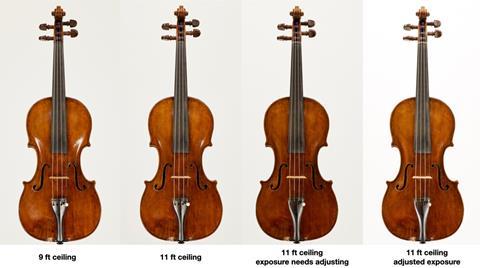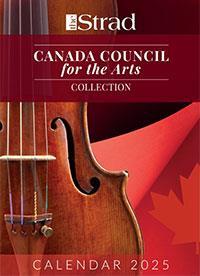The auction house’s head photographer gives details on his camera set-up, lighting, studio layout and the different requirements of front, side, back and scroll shots

Discover more lutherie articles here
Another key presentation at the Violin Society of America’s 2024 convention came from Robert Bailey, head of photography at Tarisio. Being an online auction house, Tarisio sees high-quality photography of all its instruments and bows to be of the utmost importance, and Bailey has a vital task in maintaining the high standard over hundreds of lots every year – not only in New York but at its London and Berlin offices as well. ‘When I started, I wanted to set the gold standard for violin photography,’ he began, before sharing some of the techniques developed over his years at the firm.
‘All our images must be sharp, in focus and have a good depth of field,’ he said. ‘The proportions must be precise, especially when working with bows. We use the 35mm Canon EOS system. It has a great full-frame sensor, delivers a high-quality file size and offers excellent colour range. It’s a great camera for what we need it to do – and I say that because it’s not a one-size-fits-all solution and there are many camera options available. I’ve also shot with Hasselblad, Phase One, Fuji and Nikon, and I would encourage you to explore which camera system works best for you before you make a purchase.
Read: Where the wood came from: Peter Ratcliff speaks to the VSA
Read: Winners announced at 2024 VSA instrument making competition

’My main lens is the Canon EF 100mm f2.8L macro lens. 95% of all photos you see on the Tarisio website are shot with this lens. It has excellent optics, the focus is razor-sharp, very low distortion, and it works well with close-ups. The Canon 24-70 2.8 zoom is the lens I use for wider shots. I photograph all instruments and bows as RAW files at 100 ISO, f/11, @ 160 sec. Our Manfrotto tripod and tripod head work great for studio photography. It’s able to raise the camera above six feet and has adjustable leg braces for lower positions. Black is the necessary colour for our tripod and all of our stands, as it helps to minimise reflections.’ The camera set-up is standardised for the New York, London and Berlin offices.
For the lighting system, he uses a Profoto air remote. ‘What’s most important is to wirelessly sync the flash with the camera, as well as to control the lights – if they’re up at the ceiling, I don’t need to climb up to them.’ The actual lights he uses are Profoto monolights, pointed into an umbrella ‘to make the light source larger and the light softer’. To photograph instrument backs he also employs a honeycomb grid.

Tarisio’s photo studio in New York is 18.5ft long and 13.5ft wide, which is adequate for a cello when taking with a 35mm lens. The ceiling is 11ft high. There are no windows to the outside, to minimise colour contamination, and the back wall is covered in white paper. The walls of the studio are lined with black foam, which minimises reflection and light spill.
The instrument is supported on a heavy-duty C stand, so it can be easily raised and lowered, with a separate bass plate and riser, an attached boom arm and a sandbag for stability. Four lights are set up around the instrument: two at the ceiling and two at the floor. Before the instrument is fixed in position, he puts a ColorChecker Passport in its place. ‘This gets us close to the correct colour, although we have to make final adjustments for every instrument. We turn off the room lights, set the strobes to equal power, and correct the colour balance.’ Only then is the ColorChecker replaced with an instrument.
All Tarisio’s instruments are photographed in eight different positions: front, back, bass side, treble side, and four views of the scroll. For the first four, the violin must be perfectly centred. The lights are positioned round it at 45-degree angles. The light is bright and evenly distributed, minimising any distracting reflections and shadows, such as around the bridge, tailpiece or fingerboard. Reflection and flare may be a problem on instruments with high archings, but raising the two top lights a few feet higher will often be enough to reduce this. This is why the ceiling is 11ft high.

The same lighting set-up can then be used to photograph the bass and treble sides, so three of the four positions can be achieved fairly quickly. Lighting the back is much more difficult, and requires a completely different set-up. The lighting has to be constructed step by step, first by bringing in two lights with no modifiers. They are positioned above the violin and directed towards the floor, to illuminate the top two thirds of the back with a hard light. Two pieces of black cardboard will block this hard light from entering the camera directly. Then a third light is brought in, aimed towards the bottom third of the back. A 10 degree grid is used, so they can match the exposure from the grid light.
Then two more lights are positioned halfway up: ‘We don’t want any light to affect the violin, so we put aluminium foil to guide the light so it doesn’t hit the instrument.’ Then the ColorChecker passport is put in position again, the colours checked, and the replaced with the instrument – the centre of the back positioned at exactly the same point as the ColorChecker.
For the four scroll positions, the acrylic 3x3 riser is switched out in favour of a platform, on which a padded box is positioned. This will contain the violin. A softer light is needed, and only two lights rather than four. The scroll should be evenly lit, with all distracting shadows (e.g. from the pegs) minimised as far as possible.
All photos Robert Bailey/Tarisio
Read: ‘Salabue, Matsuda’ Stradivari violin fetches $3.48 million at auction
Read: New York Philharmonic concertmaster acquires Pierre Simon bow
An exclusive range of instrument making posters, books, calendars and information products published by and directly for sale from The Strad.
The Strad’s exclusive instrument posters, most with actual-size photos depicting every nuance of the instrument. Our posters are used by luthiers across the world as models for their own instruments, thanks to the detailed outlines and measurements on the back.
The number one source for a range of books covering making and stringed instruments with commentaries from today’s top instrument experts.
The Canada Council of the Arts’ Musical Instrument Bank is 40 years old in 2025. This year’s calendar celebrates some its treasures, including four instruments by Antonio Stradivari and priceless works by Montagnana, Gagliano, Pressenda and David Tecchler.
Violin Society of America’s 50th convention kicks off in Indianapolis
- 1
- 2
 Currently reading
Currently readingHow to photograph violins: Tarisio’s Robert Bailey speaks to the VSA
- 3
- 4
- 5
- 6

















































No comments yet